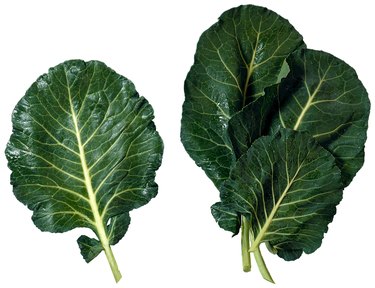
Americans, especially from the Deep South, eat collard greens as a cool-season alternative to cabbage. Belonging to the diverse species Brassica oleracea, collards are closely related to kale, kohlrabi, broccoli, cabbage and cauliflower. They are ready to harvest 30 to 80 days after sowing, depending on the leaf size or flavor desired. Tolerant of frost, they are best grown from late summer to late spring when temperatures don't often exceed 85 degrees Fahrenheit.
Growing Seasons
Video of the Day
Depending on the climate, collards may be planted in either early spring, late summer or both. Sowing seeds or planting seedlings in March or April leads to a harvest in May or June. Another sowing or planting occurs in late summer, usually late August, for harvest in October and November. In subtropical parts of the United States, collards grow best from November to March when the coolest day temperatures exist and frosts and freezes occasionally occur.
Video of the Day
Prolonging Productivity
Because collards endure through frosts, freezes and substantial summertime heat, you can prolong the productive season more easily than other leafy crops. Collards mature as bushy plants, so as seedlings sprout, thin the plants out so their leaves barely touch one another. As the plants are pulled out for more growing room, eat the foliage. When summer heat begins to build, ensure the soil is consistently but evenly moist to prevent the plants from wilting or going to flower. Sow seeds in succession every two to four weeks for a continual plant crop.
Determining Planting Time
Collards do not have to be mature plants before leaves are harvested to eat. While a larger plant produces more foliage, smaller plants are still useful in salads. Sow seeds in spring four to eight weeks before the last spring frost date in your area. Alternatively, sow them in late summer two to eight weeks before the first expected frost. Plants grow well in sunny vegetable patches when the daytime temperatures reach the 40 to 80 degree range.
Recommendations
For the most accurate, tried-and-true insight on when to sow collards where you live, contact your county cooperative extension office. Speak with a horticultural agent or master gardener who can answer your questions pertaining to your climate, soil and likely threats of disease and insect pests. Sow collard seeds 1/4 inch deep, spaced 1 inch apart in a row. They sprout in 10 to 14 days, or in as little as six days in late summer's warm soils. The first thinning of plants leaves plants spaced every 4 to 6 inches. Harvest as needed, but keep increasing plant spacing of remaining plants to promote robust, uniform leafing.